Spanish missions in California
Part of a series on |
| Spanish missions in the Americas of the Catholic Church |
|---|
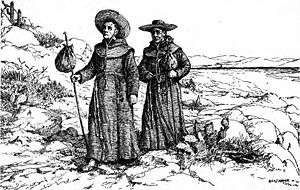 The Missionaries as They Came and Went |
| Missions |
|
|
| Part of a series on the |
| Spanish missions in California |
|---|
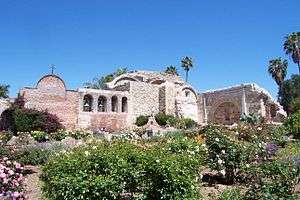
The Spanish missions in California comprise a series of 21 religious outposts; established by Catholic priests of the Franciscan order between 1769 and 1833, to expand Christianity among the Native Americans northwards into what is today the U.S. state of California. The missions were part of a major effort by the Spanish Empire to extend colonization into the most northern and western parts of Spain's North American claims. Following a long-term secular and religious policy of Spain in Latin America, the missionaries forced the native Californians to live in settlements called reductions. The missionaries introduced European fruits, vegetables, cattle, horses, ranching and technology into the region that became the New Spain province of Alta California; however, the missions also brought serious negative consequences to the Native American populations with whom the missionaries and other Spaniards came in contact.
Mexico achieved independence in 1821, taking Alta California along with it, but the missions maintained authority over native neophytes and control of vast land holdings until the 1830s. At the peak of its development in 1832, the coastal mission system controlled an area equal to approximately one-sixth of Alta California.[3] The Alta California government secularized the missions after the passage of the Mexican secularization act of 1833. This divided the mission lands into land grants, which became many of the Ranchos of California.
In the end, the missions had mixed results in their objectives: to convert, educate, and "civilize" the indigenous population and transform the natives into Spanish colonial citizens. Despite the fact that the original administrative system of Spanish missions no longer survives, still the impact that the mission-system has had on California culture, economics, and place histories can yet be felt to this day. Today, the surviving mission buildings are the state's oldest structures, and its most-visited historic monuments.
Alta California mission planning, structure and culture
Coastal mission chain, planning and overview
Prior to 1754, grants of mission lands were made directly by the Spanish Crown. But, given the remote locations and the inherent difficulties in communicating with the territorial governments, power was transferred to the viceroys of New Spain to grant lands and establish missions in North America.[4] Plans for the Alta California missions were laid out under the reign of King Charles III), and came at least in part as a response to recent sightings of Russian fur traders along the California coast in the mid 1700s.[5] The missions were to be interconnected by an overland route which later became known as the Camino Real. The detailed planning and direction of the missions was to be carried out by Friar Junípero Serra, O.F.M. (who, in 1767, along with his fellow priests, had taken control over a group of missions in Baja California Peninsula previously administered by the Jesuits).
The Rev. Fermín Francisco de Lasuén took up Serra's work and established nine more mission sites, from 1786 through 1798; others established the last three compounds, along with at least five asistencias (mission assistance outposts).[6]
Shelved plans for additional mission chains
Work on the coastal mission chain was concluded in 1823, completed after Serra's death in 1784. Plans to build a twenty-second mission in Santa Rosa in 1827 were canceled.[notes 1]
The Rev. Pedro Estévan Tápis proposed establishing a mission on one of the Channel Islands in the Pacific Ocean off San Pedro Harbor in 1784, with either Santa Catalina or Santa Cruz (known as Limú to the Tongva residents) being the most likely locations, the reasoning being that an offshore mission might have attracted potential people to convert who were not living on the mainland, and could have been an effective measure to restrict smuggling operations.[7] Governor José Joaquín de Arrillaga approved the plan the following year, however an outbreak of sarampion (measles) killing some 200 Tongva people coupled with a scarcity of land for agriculture and potable water left the success of such a venture in doubt, so no effort to found an island mission was ever made.
In September, 1821 the Rev. Mariano Payeras, "Comisario Prefecto" of the California missions, visited Cañada de Santa Ysabel east of Mission San Diego de Alcalá as part of a plan to establish an entire chain of inland missions. The Santa Ysabel Asistencia had been founded in 1818 as a "mother" mission, however the plan's expanding beyond never came to fruition.
Mission sites, selection and layout

In addition to the presidio (royal fort) and pueblo (town), the misión was one of the three major agencies employed by the Spanish sovereign to extend its borders and consolidate its colonial territories. Asistencias ("satellite" or "sub" missions, sometimes referred to as "contributing chapels") were small-scale missions that regularly conducted Mass on days of obligation but lacked a resident priest;[8] as with the missions, these settlements were typically established in areas with high concentrations of potential native converts.[9] The Spanish Californians had never strayed from the coast when establishing their settlements; Mission Nuestra Señora de la Soledad was located farthest inland, being only some thirty miles (48 kilometers) from the shore.[10] Each frontier station was forced to be self-supporting, as existing means of supply were inadequate to maintain a colony of any size. California was months away from the nearest base in colonized Mexico, and the cargo ships of the day were too small to carry more than a few months’ rations in their holds. To sustain a mission, the padres required converted Native Americans, called neophytes, to cultivate crops and tend livestock in the volume needed to support a fair-sized establishment. The scarcity of imported materials, together with a lack of skilled laborers, compelled the missionaries to employ simple building materials and methods in the construction of mission structures.

Although the missions were considered temporary ventures by the Spanish hierarchy, the development of an individual settlement was not simply a matter of "priestly whim." The founding of a mission followed longstanding rules and procedures; the paperwork involved required months, sometimes years of correspondence, and demanded the attention of virtually every level of the bureaucracy. Once empowered to erect a mission in a given area, the men assigned to it chose a specific site that featured a good water supply, plenty of wood for fires and building materials, and ample fields for grazing herds and raising crops. The padres blessed the site, and with the aid of their military escort fashioned temporary shelters out of tree limbs or driven stakes, roofed with thatch or reeds (cañas). It was these simple huts that ultimately gave way to the stone and adobe buildings that exist to the present.
The first priority when beginning a settlement was the location and construction of the church (iglesia). The majority of mission sanctuaries were oriented on a roughly east-west axis to take the best advantage of the sun's position for interior illumination; the exact alignment depended on the geographic features of the particular site. Once the spot for the church had been selected, its position was marked and the remainder of the mission complex was laid out. The workshops, kitchens, living quarters, storerooms, and other ancillary chambers were usually grouped in the form of a quadrangle, inside which religious celebrations and other festive events often took place. The cuadrángulo was rarely a perfect square because the missionaries had no surveying instruments at their disposal and simply measured off all dimensions by foot. Some fanciful accounts regarding the construction of the missions claimed that underground tunnels were incorporated in the design, to be used as a means of emergency egress in the event of attack; however, no historical evidence (written or physical) has ever been uncovered to support these assertions.[11][notes 2]
Franciscans and native conscription
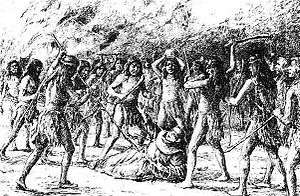
The Alta California missions, known as reductions (reducciones) or congregations (congregaciones), were settlements founded by the Spanish colonizers of the New World with the purpose of totally assimilating indigenous populations into European culture and the Catholic religion. It was a doctrine established in 1531, which based the Spanish state's right over the land and persons of the Indies on the Papal charge to evangelize them. It was employed wherever the indigenous populations were not already concentrated in native pueblos. Indians were congregated around the mission proper through forced resettlement, in which the Spanish "reduced" them from what they perceived to be a free "undisciplined'" state with the ambition of converting them into "civilized" members of colonial society.[16] The civilized and disciplined culture of the natives, developed over 8,000 year, was not considered. A total of 146 Friars Minor, mostly Spaniards by birth, were ordained as priests and served in California between 1769 and 1845. Sixty-seven missionaries died at their posts (two as martyrs: Padres Luis Jayme and Andrés Quintana), while the remainder returned to Europe due to illness, or upon completing their ten-year service commitment.[17] As the rules of the Franciscan Order forbade friars to live alone, two missionaries were assigned to each settlement, sequestered in the mission's convento.[18] To these the governor assigned a guard of five or six soldiers under the command of a corporal, who generally acted as steward of the mission's temporal affairs, subject to the priests' direction.[19]
Indians were initially attracted into the mission compounds by gifts of food, colored beads, bits of bright cloth, and trinkets. Once a Native American "gentile" was baptized, they were labeled a neophyte, or new believer. This happened only after a brief period during which the initiates were instructed in the most basic aspects of the Catholic faith. But, while many natives were lured to join the missions out of curiosity and sincere desire to participate and engage in trade, many found themselves trapped once they were baptised.[20]
To the padres, a baptized Indian person was no longer free to move about the country, but had to labor and worship at the mission under the strict observance of the priests and overseers, who herded them to daily masses and labors. If an Indian did not report for their duties for a period of a few days, they were searched for, and if it was discovered that they had left without permission, they were considered runaways. Large-scale military expeditions were organized to round up the escaped neophytes. Sometimes the Franciscans even permitted neophytes to escape to their villages, so that an expedition might be organized to follow them and in the process of capturing the fugitives, a dozen or more new "Christians" could be rounded up.
On one occasion," writes Hugo Reid, "they went as far as the present Rancho del Chino, where they tied and whipped every man, woman and child in the lodge, and drove part of them back.... On the road they did the same with those of the lodge at San Jose. On arriving home the men were instructed to throw their bows and arrows at the feet of the priest, and make due submission. The infants were then baptized, as were also all children under eight years of age; the former were left with their mothers, but the latter kept apart from all communication with their parents. The consequence was, first, the women consented to the rite and received it, for the love they bore their children; and finally the males gave way for the purpose of enjoying once more the society of wife and family. Marriage was then performed, and so this contaminated race, in their own sight and that of their kindred, became followers of Christ.[20]
A total of 20,355 natives were "attached" to the California missions in 1806 (the highest figure recorded during in the Mission Period); under Mexican rule the number rose to 21,066 (in 1824, the record year during the entire era of the Franciscan missions).[21][notes 5] During the entire period of Mission rule, from 1769 to 1834, the Franciscans baptized 53,600 adult Indians and buried 37,000. Dr. Cook estimates that 15,250 or 45% of the population decrease was caused by disease. Two epidemics of measles, one in 1806 and the other in 1828, caused many deaths. The mortality rates were so high that the missions were constantly dependent upon new conversions.[20]
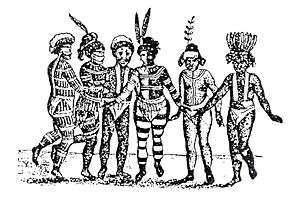
Young native women were required to reside in the monjerío (or "nunnery") under the supervision of a trusted Indian matron who bore the responsibility for their welfare and education. Women only left the convent after they had been "won" by an Indian suitor and were deemed ready for marriage. Following Spanish custom, courtship took place on either side of a barred window. After the marriage ceremony the woman moved out of the mission compound and into one of the family huts.[23] These "nunneries" were considered a necessity by the priests, who felt the women needed to be protected from the men, both Indian and de razón (real men, i.e. Europeans). The cramped and unsanitary conditions the girls lived in contributed to the fast spread of disease and population decline. So many died at times that many of the Indian residents of the missions urged the priests to raid new villages to supply them with more women. As of December 31, 1832 (the peak of the mission system's development) the mission padres had performed a combined total of 87,787 baptisms and 24,529 marriages, and recorded 63,789 deaths.[24]
The neophytes were kept in well-guarded mission compounds. The policy of the Franciscans was to keep them constantly occupied. "If the Indian would not work," writes C. D. Willard, "he was starved and flogged. If he ran away he was pursued and brought back."[20]
Bells were vitally important to daily life at any mission. The bells were rung at mealtimes, to call the Mission residents to work and to religious services, during births and funerals, to signal the approach of a ship or returning missionary, and at other times; novices were instructed in the intricate rituals associated with the ringing the mission bells. The daily routine began with sunrise Mass and morning prayers, followed by instruction of the natives in the teachings of the Roman Catholic faith. After a generous (by era standards) breakfast of atole, the able-bodied men and women were assigned their tasks for the day. The women were committed to dressmaking, knitting, weaving, embroidering, laundering, and cooking, while some of the stronger girls ground flour or carried adobe bricks (weighing 55 lb, or 25 kg each) to the men engaged in building. The men worked a variety of jobs, having learned from the missionaries how to plow, sow, irrigate, cultivate, reap, thresh, and glean. In addition, they were taught to build adobe houses, tan leather hides, shear sheep, weave rugs and clothing from wool, make ropes, soap, paint, and other useful duties.
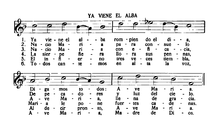
The work day was six hours, interrupted by dinner (lunch) around 11:00 a.m. and a two-hour siesta, and ended with evening prayers and the rosary, supper, and social activities. About 90 days out of each year were designated as religious or civil holidays, free from manual labor. The labor organization of the missions resembled a slave plantation in many respects.[26][notes 6] Foreigners who visited the missions remarked at how the priests' control over the Indians appeared excessive, but necessary given the white men's isolation and numeric disadvantage.[27][notes 7] Indians were not paid wages as they were not considered free laborers and, as a result, the missions were able to profit from the goods produced by the Mission Indians to the detriment of the other Spanish and Mexican settlers of the time who could not compete economically with the advantage of the mission system.[28]
The Franciscans began to send neophytes to work as servants of Spanish soldiers in the presidios. Each presidio was provided with land, el rancho del rey, which served as a pasture for the presidio livestock and as a source of food for the soldiers. Theoretically the soldiers were supposed to work on this land themselves but within a few years the neophytes were doing all the work on the presidio farm and, in addition, were serving domestics for the soldiers. While the fiction prevailed that neophytes were to receive wages for their work, no attempt was made to collect the wages for these services after 1790. It is recorded that the neophytes performed the work "under unmitigated compulsion."[20]
In recent years, much debate has arisen as to the actual treatment of the Indians during the Mission period, and many claim that the California mission system is directly responsible for the decline of the native cultures.[27][notes 8] Evidence has now been brought to light that puts the Indians' experiences in a very different context.[29][notes 9][30][notes 10]
The missionaries of California were by-and-large well-meaning, devoted men...[whose] attitudes toward the Indians ranged from genuine (if paternalistic) affection to wrathful disgust. They were ill-equipped—nor did most truly desire—to understand complex and radically different Native American customs. Using European standards, they condemned the Indians for living in a "wilderness," for worshipping false gods or no God at all, and for having no written laws, standing armies, forts, or churches.[31]
Mission industries
The goal of the missions was, above all, to become self-sufficient in relatively short order. Farming, therefore, was the most important industry of any mission. Barley, maize, and wheat were among the most common crops grown. Cereal grains were dried and ground by stone into flour. Even today, California is well known for the abundance and many varieties of fruit trees that are cultivated throughout the state. The only fruits indigenous to the region, however, consisted of wild berries or grew on small bushes. Spanish missionaries brought fruit seeds over from Europe, many of which had been introduced from Asia following earlier expeditions to the continent; orange, grape, apple, peach, pear, and fig seeds were among the most prolific of the imports. Grapes were also grown and fermented into wine for sacramental use and again, for trading. The specific variety, called the Criolla or Mission grape, was first planted at Mission San Juan Capistrano in 1779; in 1783, the first wine produced in Alta California emerged from the mission's winery. Ranching also became an important mission industry as cattle and sheep herds were raised.
Mission San Gabriel Arcángel unknowingly witnessed the origin of the California citrus industry with the planting of the region's first significant orchard in 1804, though the commercial potential of citrus was not realized until 1841.[32] Olives (first cultivated at Mission San Diego de Alcalá) were grown, cured, and pressed under large stone wheels to extract their oil, both for use at the mission and to trade for other goods. The Rev. Serra set aside a portion of the Mission Carmel gardens in 1774 for tobacco plants, a practice that soon spread throughout the mission system.[33][notes 11]
It was also the missions' responsibility to provide the Spanish forts, or presidios, with the necessary foodstuffs, and manufactured goods to sustain operations. It was a constant point of contention between missionaries and the soldiers as to how many fanegas[34] of barley, or how many shirts or blankets the mission had to provide the garrisons on any given year. At times these requirements were hard to meet, especially during years of drought, or when the much anticipated shipments from the port of San Blas failed to arrive. The Spaniards kept meticulous records of mission activities, and each year reports submitted to the Father-Presidente summarizing both the material and spiritual status at each of the settlements.
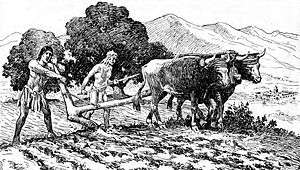
Livestock was raised, not only for the purpose of obtaining meat, but also for wool, leather, and tallow, and for cultivating the land. In 1832, at the height of their prosperity, the missions collectively owned:
- 151,180 head of cattle;
- 137,969 sheep;
- 14,522 horses;
- 1,575 mules or burros;
- 1,711 goats; and
- 1,164 swine.[35]
All these grazing animals were originally brought up from Mexico. A great many Indians were required to guard the herds and flocks on the mission ranches, which created the need for "...a class of horsemen scarcely surpassed anywhere."[19] These animals multiplied beyond the settler's expectations, often overrunning pastures and extending well-beyond the domains of the missions. The giant herds of horses and cows took well to the climate and the extensive pastures of the Coastal California region, but at a heavy price for the California Native American people. The uncontrolled spread of these new herds, and associated invasive exotic plant species, quickly exhausted the native plants in the grasslands,[36] and the chaparral and woodlands that the Indians depended on for their seed, foliage, and bulb harvests. The grazing-overgrazing problems were also recognized by the Spaniards, who periodically had extermination parties cull and kill thousands of excess livestock, when herd populations grew beyond their control or the land's capacity. Years with a severe drought did this also.
Mission kitchens and bakeries prepared and served thousands of meals each day. Candles, soap, grease, and ointments were all made from tallow (rendered animal fat) in large vats located just outside the west wing. Also situated in this general area were vats for dyeing wool and tanning leather, and primitive looms for weaving. Large bodegas (warehouses) provided long-term storage for preserved foodstuffs and other treated materials.

Each mission had to fabricate virtually all of its construction materials from local materials. Workers in the carpintería (carpentry shop) used crude methods to shape beams, lintels, and other structural elements; more skilled artisans carved doors, furniture, and wooden implements. For certain applications bricks (ladrillos) were fired in ovens (kilns) to strengthen them and make them more resistant to the elements; when tejas (roof tiles) eventually replaced the conventional jacal roofing (densely packed reeds) they were placed in the kilns to harden them as well. Glazed ceramic pots, dishes, and canisters were also made in mission kilns.
Prior to the establishment of the missions, the native peoples knew only how to utilize bone, seashells, stone, and wood for building, tool making, weapons, and so forth. The missionaries established manual training in European skills and methods; in agriculture, mechanical arts, and the raising and care of livestock. Everything consumed and otherwise utilized by the natives was produced at the missions under the supervision of the padres; thus, the neophytes not only supported themselves, but after 1811 sustained the entire military and civil government of California.[37] The foundry at Mission San Juan Capistrano was the first to introduce the Indians to the Iron Age. The blacksmith used the mission's forges (California's first) to smelt and fashion iron into everything from basic tools and hardware (such as nails) to crosses, gates, hinges, even cannon for mission defense. Iron in particular was a commodity that the mission acquired solely through trade, as the missionaries had neither the know-how nor technology to mine and process metal ores.
No study of the missions is complete without mention of their extensive water supply systems. Stone zanjas (aqueducts, sometimes spanning miles, brought fresh water from a nearby river or spring to the mission site. Open or covered lined ditches and/or baked clay pipes, joined together with lime mortar or bitumen, gravity-fed the water into large cisterns and fountains, and emptied into waterways where the force of the water was used to turn grinding wheels and other simple machinery, or dispensed for use in cleaning. Water used for drinking and cooking was allowed to trickle through alternate layers of sand and charcoal to remove the impurities. One of the best-preserved mission water systems is at Mission Santa Barbara.[38]
History
Beginning in 1492 with the voyages of Christopher Columbus, the Kingdom of Spain sought to establish missions to convert indigenous people in Nueva España (New Spain), which consisted of the Caribbean, Mexico, and most of what is now the Southwestern United States) to Roman Catholicism. This would facilitate colonization of these lands awarded to Spain by the Catholic Church, including that region later known as Alta California.[notes 12][notes 13][39][notes 14]
Early Spanish exploration
Only 48 years after Columbus discovered the Americas for Europe, Francisco Vázquez de Coronado set out from Compostela, New Spain on February 23, 1540, at the head of a large expedition. Accompanied by 400 European men-at-arms (mostly Spaniards), 1,300 to 2,000 Mexican Indian allies, several Indian and African slaves, and four Franciscan monks, he traveled from Mexico through parts of the southwestern United States to present-day Kansas between 1540 and 1542.[40][41] Two years later on 27 June 1542, Juan Rodriguez Cabrillo set out from Navidad, Mexico and sailed up the coast of Baja California and into the region of Alta California.[42]
Secret English claims
Unknown to Spain, Sir Francis Drake, an English privateer[43] who pillaged Spanish ships and settlements,[44] claimed the Alta California region for England in 1579, a full generation before the first English landing in Jamestown, Virginia in 1607. During his circumnavigation of the world, Drake anchored in a harbor just north of present-day San Francisco, California, and claimed the territory for Queen Elizabeth I. To preserve an uneasy peace with Spain and to avoid the prospect of Spain threatening England's claims in the New World, Queen Elizabeth I ordered Drake's discovery and claim kept secret.[45]
Russian exploration
However, it wasn't until 1741 that the Spanish monarchy of King Philip V was stimulated to consider how to protect his claims to Alta California. Philip was spurred on when the territorial ambitions of Tsarist Russia were expressed in the Vitus Bering expedition along the western coast on the North American continent.[46][47][notes 15][48][notes 16]
Spanish expansion
California represents the "high-water mark" of Spanish expansion in North America as the last and northernmost colony on the continent.[49] The mission system arose in part from the need to control Spain's ever-expanding holdings in the New World. Realizing that the colonies required a literate population base that the mother country could not supply, the Spanish government (with the cooperation of the Church) established a network of missions to convert the indigenous population to Christianity. They aimed to make converts and tax-paying citizens of those they conquered.[30][notes 17] To make them into Spanish citizens and productive inhabitants, the Spanish government and the Church required the indigenous people to learn Spanish language and vocational skills along with Christian teachings.[50]
Estimates for the pre-contact indigenous population in California are based on a number of different sources and vary substantially, from 133,000,[51] to 225,000,[52] to as high as 705,000 from more than 100 separate tribes or nations.[53][54][notes 18][notes 19]
On January 29, 1767, Spain's King Charles III ordered the new governor Gaspar de Portolá to forcibly expel the Jesuits, who operated under the authority of the Pope and had established a chain of fifteen missions on the Baja California Peninsula.[55][notes 20] Visitador General José de Gálvez engaged the Franciscans, under the leadership of Friar Junípero Serra, to take charge of those outposts on March 12, 1768.[56] The padres closed or consolidated several of the existing settlements, and also founded Misión San Fernando Rey de España de Velicatá (the only Franciscan mission in all of Baja California) and the nearby Visita de la Presentación in 1769. This plan, however, changed within a few months after Gálvez received the following orders: "Occupy and fortify San Diego and Monterey for God and the King of Spain."[57] The Church ordered the priests of the Dominican Order to take charge of the Baja California missions so the Franciscans could concentrate on founding new missions in Alta California.
Mission period (1769–1833)
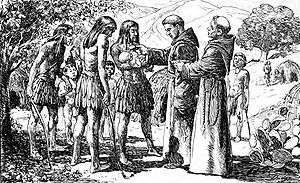
On July 14, 1769 Gálvez sent the Portolá expedition out from Loreto to explore lands to the north. Leader Gaspar de Portolá was accompanied by a group of Franciscans led by Junípero Serra. Serra's plan was to extend the string of missions north from the Baja California peninsula, connected by an established road and spaced a day's travel apart. The first Alta California mission and presidio were founded at San Diego, the second at Monterey.[59]
En route to Monterey, the Rev. Francisco Gómez and the Rev. Juan Crespí came across a Native settlement wherein two young girls were dying: one, a baby, said to be "dying at its mother's breast," the other a small girl suffering of burns. On July 22, Gómez baptized the baby, naming her Maria Magdalena, while Crespí baptized the older child, naming her Margarita. These were the first recorded baptisms in Alta California.[60] Crespi dubbed the spot Los Cristianos.[58][notes 21] The group continued northward but missed Monterey Harbor and returned to San Diego on January 24, 1770. Near the end of 1769 the Portolá expedition had reached its most northerly point at present-day San Francisco. In following years, the Spanish Crown sent a number of follow-up expeditions to explore more of Alta California.

Each mission was to be turned over to a secular clergy and all the common mission lands distributed amongst the native population within ten years after its founding, a policy that was based upon Spain's experience with the more advanced tribes in Mexico, Central America, and Peru.[62] In time, it became apparent to the Rev. Serra and his associates that the natives on the northern frontier in Alta California required a much longer period of acclimatization.[19] None of the California missions ever attained complete self-sufficiency, and required continued (albeit modest) financial support from mother Spain.[63] Mission development was therefore financed out of El Fondo Piadoso de las Californias (The Pious Fund of the Californias), which originated in 1697 and consisted of voluntary donations from individuals and religious bodies in Mexico to members of the Society of Jesus) to enable the missionaries to propagate the Catholic Faith in the area then known as California. Starting with the onset of the Mexican War of Independence in 1810, this support largely disappeared, and missions and converts were left on their own. As of 1800, native labor had made up the backbone of the colonial economy.[64]
Arguably "the worst epidemic of the Spanish Era in California" was known to be the measles epidemic of 1806, wherein one-quarter of the mission Native American population of the San Francisco Bay area died of the measles or related complications between March and May of that year.[65] In 1811, the Spanish Viceroy in Mexico sent an interrogatorio (questionnaire) to all of the missions in Alta California regarding the customs, disposition, and condition of the Mission Indians.[66] The replies, which varied greatly in the length, spirit, and even the value of the information contained therein, were collected and prefaced by the Father-Presidente with a short general statement or abstract; the compilation was thereupon forwarded to the viceregal government.[67][notes 22] The contemporary nature of the responses, no matter how incomplete or biased some may be, are nonetheless of considerable value to modern ethnologists.
Russian colonization of the Americas reached its southernmost point with the 1812 establishment of Fort Ross (krepost' rus), an agricultural, scientific, and fur-trading settlement located in present-day Sonoma County, California.[69] In November and December 1818, several of the missions were attacked by Hipólito Bouchard, "California's only pirate."[notes 23] A French privateer sailing under the flag of Argentina, Pirata Buchar (as he was known to the locals) worked his way down the California coast, conducting raids on the installations at Monterey, Santa Barbara, and San Juan Capistrano, with limited success.[70] Upon hearing of the attacks, many mission priests (along with a few government officials) sought refuge at Mission Nuestra Señora de la Soledad, the mission chain's most isolated outpost. Ironically, Mission Santa Cruz (though ultimately ignored by the marauders) was ignominiously sacked and vandalized by local residents who were entrusted with securing the church's valuables.[71]
By 1819, Spain decided to limit its "reach" in the New World to Northern California due to the costs involved in sustaining these remote outposts; the northernmost settlement therefore is Mission San Francisco Solano, founded in Sonoma in 1823.[72][notes 24] An attempt to found a twenty-second mission in Santa Rosa in 1827 was aborted.[72][notes 25][notes 26][73][notes 27] In 1833 the final group of missionaries arrived in Alta California. These were Mexican-born (rather than Spaniards), and had been trained at the Apostolic College of Our Lady of Guadalupe in Zacatecas. Among these friars was Francisco García Diego y Moreno, who would become the first bishop of the Diocese of Both Californias. These friars would bear the brunt of the changes brought on by secularization and the U.S. occupation, and many would marked by allegations of corruption.[74]
Secularization
As the Mexican republic matured, calls for the secularization ("disestablishment") of the missions increased.[75][notes 28]
José María de Echeandía, the first native Mexican elected Governor of Alta California issued a "Proclamation of Emancipation" (or "Prevenciónes de Emancipacion") on July 25, 1826.[76] All Indians within the military districts of San Diego, Santa Barbara, and Monterey who were found qualified were freed from missionary rule and made eligible to become Mexican citizens. Those who wished to remain under mission tutelage were exempted from most forms of corporal punishment.[77][78][notes 29] By 1830 even the neophyte populations themselves appeared confident in their own abilities to operate the mission ranches and farms independently; the padres, however, doubted the capabilities of their charges in this regard.[79]
Accelerating immigration, both Mexican and foreign, increased pressure on the Alta California government to seize the mission properties and dispossess the natives in accordance with Echeandía's directive.[80][notes 30] Despite the fact that Echeandía's emancipation plan was met with little encouragement from the novices who populated the southern missions, he was nonetheless determined to test the scheme on a large scale at Mission San Juan Capistrano. To that end, he appointed a number of comisionados (commissioners) to oversee the emancipation of the Indians.[81] The Mexican government passed legislation on December 20, 1827 that mandated the expulsion of all Spaniards younger than sixty years of age from Mexican territories; Governor Echeandía nevertheless intervened on behalf of some of the missionaries to prevent their deportation once the law took effect in California.[82]
Governor José Figueroa (who took office in 1833) initially attempted to keep the mission system intact, but the Mexican Congress passed An Act for the Secularization of the Missions of California on August 17, 1833 when liberal Valentín Gómez Farías was in office.[83][notes 31]
The Act also provided for the colonization of both Alta and Baja California, the expenses of this latter move to be borne by the proceeds gained from the sale of the mission property to private interests.
Mission San Juan Capistrano was the very first to feel the effects of secularization when, on August 9, 1834 Governor Figueroa issued his "Decree of Confiscation."[84] Nine other settlements quickly followed, with six more in 1835; San Buenaventura and San Francisco de Asís were among the last to succumb, in June and December 1836, respectively.[85] The Franciscans soon thereafter abandoned most of the missions, taking with them almost everything of value, after which the locals typically plundered the mission buildings for construction materials. Former mission pasture lands were divided into large land grants called ranchos, greatly increasing the number of private land holdings in Alta California.
Rancho period (1834–1849)
In spite of this neglect, the Indian towns at San Juan Capistrano, San Dieguito, and Las Flores did continue on for some time under a provision in Gobernador Echeandía's 1826 Proclamation that allowed for the partial conversion of missions to pueblos.[86] According to one estimate, the native population in and around the missions proper was approximately 80,000 at the time of the confiscation; others claim that the statewide population had dwindled to approximately 100,000 by the early 1840s, due in no small part to the natives' exposure to European diseases, and from the Franciscan practice of cloistering women in the convento and controlling sexuality during the child-bearing age. (Baja California Territory experienced a similar reduction in native population resulting from Spanish colonization efforts there).[87]

Pío de Jesús Pico, the last Mexican Governor of Alta California, found upon taking office that there were few funds available to carry on the affairs of the province. He prevailed upon the assembly to pass a decree authorizing the renting or the sale of all mission property, reserving only the church, a curate's house, and a building for a courthouse. The expenses of conducting the services of the church were to be provided from the proceeds, but there was no disposition made as to what should be done to secure the funds for that purpose. After secularization, Father-Presidente Narciso Durán transferred the missions' headquarters to Santa Bárbara, thereby making Mission Santa Bárbara the repository of some 3,000 original documents that had been scattered through the California missions. The Mission archive is the oldest library in the State of California that still remains in the hands of its founders, the Franciscans (it is the only mission where they have maintained an uninterrupted presence). Beginning with the writings of Hubert Howe Bancroft, the library has served as a center for historical study of the missions for more than a century. In 1895 journalist and historian Charles Fletcher Lummis criticized the Act and its results, saying:
Disestablishment—a polite term for robbery—by Mexico (rather than by native Californians misrepresenting the Mexican government) in 1834, was the death blow of the mission system. The lands were confiscated; the buildings were sold for beggarly sums, and often for beggarly purposes. The Indian converts were scattered and starved out; the noble buildings were pillaged for their tiles and adobes...[89]
California statehood (1850 and beyond)

Precise figures relating to the population decline of California indigenes are not available. One writer, Gregory Orfalea, estimates that pre-contact population was reduced by 33 percent during Spanish and Mexican rule, mostly through introduction of European diseases, but much more after the United States takeover in 1848. By 1870, the loss of indigenous lives had become catastrophic. Up to 80 percent died, leaving a population of about 30,000 in 1870. Orfalea claims that nearly half of the native deaths after 1848 were murder.[52]
In 1837-38, a major smallpox epidemic devastated native tribes north of San Francisco Bay, in the jurisdiction of Mission San Francisco Solano. General Mariano Vallejo estimated that 70,000 died from the disease.[90] Vallejo's ally, chief Sem-Yeto, was one of the few natives to be vaccinated, and one of the few to survive.
When the mission properties were secularized between 1834 and 1838, the approximately 15,000 resident neophytes lost whatever protection the mission system afforded them. While under the secularization laws the natives were to receive up to one-half of the mission properties, this never happened. The natives lost whatever stock and movable property they may have accumulated. When California became a U.S. state, California law stripped them of legal title to the land. In the Act of September 30, 1850, Congress appropriated funds to allow the President to appoint three Commissioners, O. M. Wozencraft, Redick McKee and George W. Barbour, to study the California situation and "...negotiate treaties with the various Indian tribes of California." Treaty negotiations ensued during the period between March 19, 1851 and January 7, 1852, during which the Commission interacted with 402 Indian chiefs and headmen (representing approximately one-third to one-half of the California tribes) and entered into eighteen treaties.[91]
California Senator William M. Gwin's Act of March 3, 1851 created the Public Land Commission, whose purpose was to determine the validity of Spanish and Mexican land grants in California.[92] On February 19, 1853 Archbishop J.S. Alemany filed petitions for the return of all former mission lands in the state. Ownership of 1,051.44 acres (4.2550 km2) (essentially exact area of land occupied by the original mission buildings, cemeteries, and gardens) was subsequently conveyed to the Church, along with the Cañada de los Pinos (or College Rancho) in Santa Barbara County comprising 35,499.73 acres (143.6623 km2), and La Laguna in San Luis Obispo County, consisting of 4,157.02 acres (16.8229 km2).[93] As the result of a U.S. government investigation in 1873, a number of Indian reservations were assigned by executive proclamation in 1875. The commissioner of Indian affairs reported in 1879 that the number of Mission Indians in the state was down to around 3,000.[94]
Legacy and Native American controversy
There is controversy over the California Department of Education's treatment of the missions in the Department's elementary curriculum; in the tradition of historical revisionism, it has been alleged that the curriculum "waters down" the harsh treatment of Native Americans. Modern anthropologists cite a cultural bias on the part of the missionaries that blinded them to the natives' plight and caused them to develop strong negative opinions of the California Indians.[95][notes 32] European diseases that the California Native Americans had no immunity to caused a significant population reduction from the first encounter through the 19th century.
Impact on modern day California
The impact that the original Spanish system of colonization had on modern day California cannot be overstated. Although the certain cooperation between Church and State that was part and parcel of the original California mission system was soon discarded by the Mexican government, it nonetheless provided a foundation upon which later forms of government would soon be established.[96] The early missions and their sub-missions formed the nuclei of what would later become the major metropolitan areas of San Francisco and Los Angeles, as well as many other smaller municipalities.[97] In addition to clearing the way for Spanish, Hispanic, and later American settlers, the early Spanish mission system established the viability of the early Western economies of cattle and agriculture which survive in modern form in the state to this day. The Spanish mission system acted to "settle and Westernize" California, but unfortunately did so very much at the expense of the earlier Native American Culture of California that had preceded the Spanish mission system.[98][99]
Mission administration, locations and military districts
System Father-Presidentes
- The Rev. Junípero Serra (1769–1784)
- The Rev. Francisco Palóu (presidente pro tempore) (1784–1785)
- The Rev. Fermín Francisco de Lasuén (1785–1803)
- The Rev. Pedro Estévan Tápis (1803–1812)
- The Rev. José Francisco de Paula Señan (1812–1815)
- The Rev. Mariano Payéras (1815–1820)
- The Rev. José Francisco de Paula Señan (1820–1823)
- The Rev. Vicente Francisco de Sarría (1823–1824)
- The Rev. Narciso Durán (1824–1827)
- The Rev. José Bernardo Sánchez (1827–1831)
- The Rev. Narciso Durán (1831–1838)
- The Rev. José Joaquin Jimeno (1838–1844)
- The Rev. Narciso Durán (1844–1846)
The "Father-Presidente" was the head of the Catholic missions in Alta and Baja California. He was appointed by the College of San Fernando de Mexico until 1812, when the position became known as the "Commissary Prefect" who was appointed by the Commissary General of the Indies (a Franciscan residing in Spain). Beginning in 1831, separate individuals were elected to oversee Upper and Lower California.[100]
Mission headquarters
- Mission San Diego de Alcalá (1769–1771)
- Mission San Carlos Borromeo de Carmelo (1771–1815)
- Mission La Purísima Concepción*(1815–1819)
- Mission San Carlos Borromeo de Carmelo (1819–1824)
- Mission San José*(1824–1827)
- Mission San Carlos Borromeo de Carmelo (1827–1830)
- Mission San José*(1830–1833)
- Mission Santa Barbara (1833–1846)
† The Rev. Payeras and the Rev. Durán remained at their resident missions during their terms as Father-Presidente, therefore those settlements became the de facto headquarters (until 1833, when all mission records were permanently relocated to Santa Barbara).[83][notes 33][101]
Mission locations

There were 21 missions accompanied by military outposts in Alta California from San Diego to Sonoma, California. To facilitate travel between them on horse and foot, the mission settlements were situated approximately 30 miles (48 kilometers) apart, about one day's journey on horseback, or three days on foot. The entire trail eventually became a 600-mile (966-kilometer) long "California Mission Trail."[102]:132[103]:152 Heavy freight movement was practical only via water. Tradition has it that the padres sprinkled mustard seeds along the trail to mark it with bright yellow flowers.[104]:79[105]:260
Following the old Camino Real northwards, from San Diego through to the northern-most mission in Sonoma, California, north of San Francisco Bay, the missions were:
- Mission San Diego de Alcalá, in San Diego
- Mission San Luis Rey de Francia, in Oceanside
- Mission San Juan Capistrano, in San Juan Capistrano
- Mission San Gabriel Arcángel, in San Gabriel
- Mission San Fernando Rey de España, in Mission Hills (Los Angeles)
- Mission San Buenaventura, in Ventura
- Mission Santa Barbara, in Santa Barbara
- Mission Santa Inés, in Solvang
- Mission La Purísima Concepción, northeast of Lompoc
- Mission San Luis Obispo de Tolosa, in San Luis Obispo
- Mission San Miguel Arcángel, in San Miguel
- Mission San Antonio de Padua, northwest of Jolon
- Mission Nuestra Señora de la Soledad, south of Soledad
- Mission San Carlos Borromeo de Carmelo, in Carmel
- Mission San Juan Bautista, in San Juan Bautista
- Mission Santa Cruz, in Santa Cruz
- Mission Santa Clara de Asís, in Santa Clara
- Mission San José, in Fremont
- Mission San Francisco de Asís, in San Francisco
- Mission San Rafael Arcángel, in San Rafael
- Mission San Francisco Solano, in Sonoma
Military districts

During the Mission Period Alta California was divided into four military districts. Each was garrisoned (comandancias) by a presidio strategically placed along the California coast to protect the missions and other Spanish settlements in Upper California.[106] Each of these functioned as a base of military operations for a specific region. They were independent of one another and were organized from south to north as follows:
- El Presidio Real de San Diego founded on July 16, 1769[107] – responsible for the defense of all installations located within the First Military District (the missions at San Diego, San Luis Rey, San Juan Capistrano, and San Gabriel);[108]
- El Presidio Real de Santa Bárbara founded on April 12, 1782[109] – responsible for the defense of all installations located within the Second Military District (the missions at San Fernando, San Buenaventura, Santa Barbara, Santa Inés, and La Purísima, along with El Pueblo de Nuestra Señora la Reina de los Ángeles del Río de Porciúncula [Los Angeles]);[110]
- El Presidio Real de San Carlos de Monterey (El Castillo) founded on June 3, 1770[111] – responsible for the defense of all installations located within the Third Military District (the missions at San Luis Obispo, San Miguel, San Antonio, Soledad, San Carlos, and San Juan Bautista, along with Villa Branciforte [Santa Cruz]);[112] and
- El Presidio Real de San Francisco founded on December 17, 1776[113] – responsible for the defense of all installations located within the Fourth Military District (the missions at Santa Cruz, San José, Santa Clara, San Francisco, San Rafael, and Solano, along with El Pueblo de San José de Guadalupe [San Jose]).[114]
- El Presidio de Sonoma, or "Sonoma Barracks" (a collection of guardhouses, storerooms, living quarters, and an observation tower) was established in 1836 by Mariano Guadalupe Vallejo (the "Commandante-General of the Northern Frontier of Alta California") as a part of Mexico's strategy to halt Russian incursions into the region.[115] The Sonoma Presidio became the new headquarters of the Mexican Army in California, while the remaining presidios were essentially abandoned and, in time, fell into ruins.
An ongoing power struggle between church and state grew increasingly heated and lasted for decades. Originating as a feud between the Rev. Serra and Pedro Fages (the military governor of Alta California from 1770 to 1774, who regarded the Spanish installations in California as military institutions first and religious outposts second), the uneasy relationship persisted for more than sixty years.[116][117][notes 34] Dependent upon one another for their very survival, military leaders and mission padres nevertheless adopted conflicting stances regarding everything from land rights, the allocation of supplies, protection of the missions, the criminal propensities of the soldiers, and (in particular) the status of the native populations.[118][notes 35]
Present-day California missions
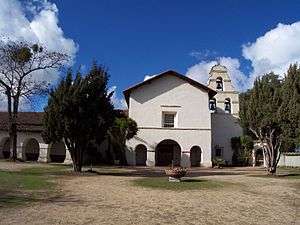
Building restoration
No other group of structures in the United States elicits the intense interest as inspired by the Missions of California (California is home to the greatest number of well-preserved missions found in any U.S. state).[45][notes 36] The missions are collectively the best-known historic element of the coastal regions of California:
- Most of the missions are still owned and operated by some entity within the Catholic Church.
- Three of the missions are still run under the auspices of the Franciscan Order (Santa Barbara, San Miguel Arcángel, and San Luis Rey de Francia)
- Four of the missions (San Diego de Alcalá, San Carlos Borromeo de Carmelo, San Francisco de Asís, and San Juan Capistrano) have been designated minor basilicas by the Holy See due to their cultural, historic, architectural, and religious importance.
- Mission La Purísima Concepción, Mission San Francisco Solano, and the one remaining mission-era structure of Mission Santa Cruz are owned and operated by the California Department of Parks and Recreation as State Historic Parks;
- Seven mission sites are designated National Historic Landmarks, fourteen are listed in the National Register of Historic Places, and all are designated as California Historical Landmarks for their historic, architectural, and archaeological significance.
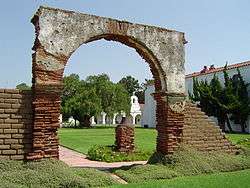
Because virtually all of the artwork at the missions served either a devotional or didactic purpose, there was no underlying reason for the mission residents to record their surroundings graphically; visitors, however, found them to be objects of curiosity.[120] During the 1850s a number of artists found gainful employment as draftsmen attached to expeditions sent to map the Pacific coastline and the border between California and Mexico (as well as plot practical railroad routes); many of the drawings were reproduced as lithographs in the expedition reports.
In 1875 American illustrator Henry Chapman Ford began visiting each of the twenty-one mission sites, where he created a historically important portfolio of watercolors, oils, and etchings. His depictions of the missions were (in part) responsible for the revival of interest in the state's Spanish heritage, and indirectly for the restoration of the missions. The 1880s saw the appearance of a number of articles on the missions in national publications and the first books on the subject; as a result, a large number of artists did one or more mission paintings, though few attempted a series.[121]
The popularity of the missions also stemmed largely from Helen Hunt Jackson's 1884 novel Ramona and the subsequent efforts of Charles Fletcher Lummis, William Randolph Hearst, and other members of the "Landmarks Club of Southern California" to restore three of the southern missions in the early 20th century (San Juan Capistrano, San Diego de Alcalá, and San Fernando; the Pala Asistencia was also restored by this effort).[122][notes 37] Lummis wrote in 1895,
In ten years from now—unless our intelligence shall awaken at once—there will remain of these noble piles nothing but a few indeterminable heaps of adobe. We shall deserve and shall have the contempt of all thoughtful people if we suffer our noble missions to fall.[123]
In acknowledgement of the magnitude of the restoration efforts required and the urgent need to have acted quickly to prevent further or even total degradation, Lummis went on to state,
It is no exaggeration to say that human power could not have restored these four missions had there been a five-year delay in the attempt.[124]
In 1911 author John Steven McGroarty penned The Mission Play, a three-hour pageant describing the California missions from their founding in 1769 through secularization in 1834, and ending with their "final ruin" in 1847.
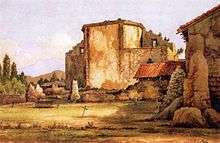
Today, the missions exist in varying degrees of architectural integrity and structural soundness. The most common extant features at the mission grounds include the church building and an ancillary convento (convent) wing. In some cases (in San Rafael, Santa Cruz, and Soledad, for example), the current buildings are replicas constructed on or near the original site. Other mission compounds remain relatively intact and true to their original, Mission Era construction.
A notable example of an intact complex is the now-threatened Mission San Miguel Arcángel: its chapel retains the original interior murals created by Salinan Indians under the direction of Esteban Munras, a Spanish artist and last Spanish diplomat to California. This structure was closed to the public from 2003 to 2009 due to severe damage from the San Simeon earthquake. Many missions have preserved (or in some cases reconstructed) historic features in addition to chapel buildings.
The missions have earned a prominent place in California's historic consciousness, and a steady stream of tourists from all over the world visit them. In recognition of that fact, on November 30, 2004 President George W. Bush signed HR 1446, the California Mission Preservation Act, into law. The measure provided $10 million over a five-year period to the California Missions Foundation for projects related to the physical preservation of the missions, including structural rehabilitation, stabilization, and conservation of mission art and artifacts. The California Missions Foundation, a volunteer, tax-exempt organization, was founded in 1998 by Richard Ameil, an eighth generation Californian.[125] A change to the California Constitution has also been proposed that would allow the use of State funds in restoration efforts.[126]
Gallery of missions
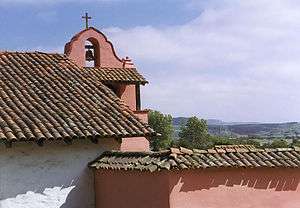 Mission La Purísima Concepción, located northeast of Lompoc.
Mission La Purísima Concepción, located northeast of Lompoc.- Mission Nuestra Señora de la Soledad, located south of Soledad.
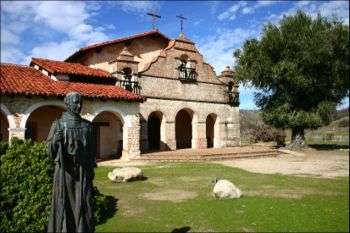 Mission San Antonio de Padua, located southwest of King City.
Mission San Antonio de Padua, located southwest of King City. Mission Santa Barbara, located in Santa Barbara.
Mission Santa Barbara, located in Santa Barbara.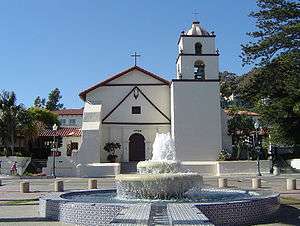 Mission San Buenaventura, located in Ventura.
Mission San Buenaventura, located in Ventura.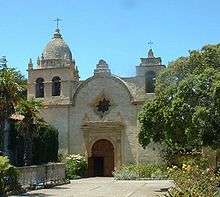 Mission San Carlos Borromeo de Carmelo, located south of Carmel.
Mission San Carlos Borromeo de Carmelo, located south of Carmel.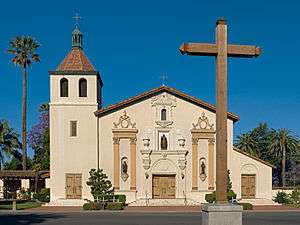 Mission Santa Clara de Asís, located in Santa Clara.
Mission Santa Clara de Asís, located in Santa Clara. Scale replica of Mission Santa Cruz chapel, located in Santa Cruz.
Scale replica of Mission Santa Cruz chapel, located in Santa Cruz.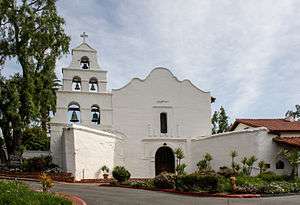 Mission San Diego de Alcalá, located in San Diego.
Mission San Diego de Alcalá, located in San Diego.
- Mission San Francisco de Asís, located in San Francisco.
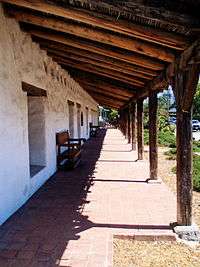 Mission San Francisco Solano, located in Sonoma.
Mission San Francisco Solano, located in Sonoma.- Mission San Gabriel Arcángel, located in San Gabriel.
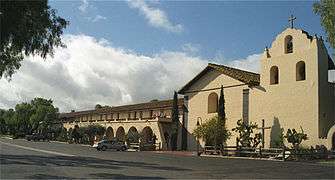 Mission Santa Inés, located in Solvang.
Mission Santa Inés, located in Solvang.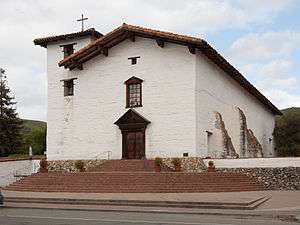 Mission San José, located in Fremont.
Mission San José, located in Fremont. Mission San Juan Bautista, located in San Juan Bautista.
Mission San Juan Bautista, located in San Juan Bautista. Mission San Juan Capistrano, located in San Juan Capistrano.
Mission San Juan Capistrano, located in San Juan Capistrano. Mission San Luis Obispo de Tolosa, located in San Luis Obispo.
Mission San Luis Obispo de Tolosa, located in San Luis Obispo.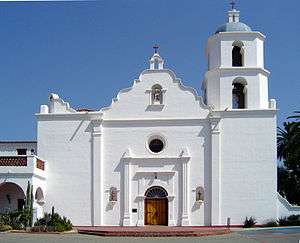 Mission San Luis Rey de Francia, located in Oceanside.
Mission San Luis Rey de Francia, located in Oceanside.- Mission San Miguel Arcángel, located in San Miguel.
 Mission San Rafael Arcángel, located in San Rafael.
Mission San Rafael Arcángel, located in San Rafael.
See also
On California Missions:
On California history:
- Juan Bautista de Anza National Historic Trail
- History of California through 1899
- California 4th Grade Mission Project
- History of the west coast of North America
On general missionary history:
On colonial Spanish American history:
- List of the oldest churches in Mexico
- Spanish colonization of the Americas
- Indian Reductions
- California mission clash of cultures
- Native Americans in the United States
Notes
- ↑ "By that time, it was found that the Russian colonies were not such undesirable neighbors as in 1817 it was thought they might become... the Russian scare, for the time being at least was over; and as for the old enthusiasm for new spiritual conquests, there was none left."
- ↑ Engelhardt: One such hypothesis was put forth by author by Prent Duel in his 1919 work Mission Architecture as Exemplified in San Xavier Del Bac: "Most missions of early date possessed secret passages as a means of escape in case they were besieged. It is difficult to locate any of them now as they are well concealed."
- ↑ Chapman: "Latter-day historians have been altogether too prone to regard the hostility to the Spaniards on the part of the California Indians as a matter of small consequence, since no disaster in fact ever happened...On the other hand the San Diego plot involved untold thousands of Indians, being virtually a national uprising, and owing to the distance from New Spain to and the extreme difficulty of maintaining communications a victory for the Indians would have ended Spanish settlement in Alta California." As it turned out, "...the position of the Spaniards was strengthened by the San Diego outbreak, for the Indians felt from that time forth that it was impossible to throw out their conquerors." See also Mission Puerto de Purísima Concepción and Mission San Pedro y San Pablo de Bicuñer regarding the Yuma 'massacres' of 1781.
- ↑ Engelhardt: Not all of the native cultures responded with hostility to the Spaniards' presence; Engelhardt portrayed the natives at Mission San Juan Capistrano (dubbed the "Juaneño" by the missionaries), where there was never any instance of unrest, as being "uncommonly friendly and docile." The Rev. Juan Crespí, who accompanied the 1769 expedition, described the first encounter with the area's inhabitants: "They came unarmed and with a gentleness which has no name they brought their poor seeds to us as gifts...The locality itself and the docility of the Indians invited the establishment of a Mission for them."
- ↑ Chapman: "Over the hills of the Coast Range, in the valleys of the Sacramento and San Joaquin, north of San Francisco Bay, and in the Sierra Nevadas of the south there were untold thousands whom the mission system never reached...they were as if in a world apart from the narrow strip of coast which was all there was of the Spanish California."
- ↑ Bennett: "The system had singularly failed in its purposes. It was the design of the Spanish government to have the missions educate, elevate, civilize, the Indians into citizens. When this was done, citizenship should be extended them and the missions should be dissolved as having served their purpose...[instead] the priests returned them projects of conversion, schemes of faith, which they never comprehended...He [the Indian] became a slave; the mission was a plantation; the friar was a taskmaster."
- ↑ Bennett: "In 1825 Governor Argüello wrote that the slavery of the Indians at the missions was bestial...Governor Figueroa declared that the missions were 'entrenchments of monastic despotism'..."
- ↑ Bennett: "It cannot be said that the mission system made the Indians more able to sustain themselves in civilization than it had found them...Upon the whole it may be said that this mission experiment was a failure."
- ↑ Lippy: "A matter of debate in reflecting on the role of Spanish missions concerns the degree to which the Spanish colonial regimes regarded the work of the priests as a legitimate religious enterprise and the degree to which it was viewed as a 'frontier institution,' part of a colonial defense program. That is, were Spanish motives based on a desire to promote conversion or on a desire to have religious missions serve as a buffer to protect the main colonial settlements and an aid in controlling the Indians?"
- ↑ Bennett: The missions in effect served as "...the citadels of the theocracy which was planted in California by Spain, under which its wild inhabitants were subjected, which stood as their guardians, civil and religious, and whose duty it was to elevate them and make them acceptable as citizens and Spanish subjects...it remained for the Spanish priests to undertake to preserve the Indian and seek to make his existence compatible with higher civilization."
- ↑ Bean: "Serra's decision to plant tobacco at the missions was prompted by the fact that from San Diego to Monterey the natives invariably begged him for Spanish tobacco."
- ↑ The Spanish claim to the Pacific Northwest dated back to a 1493 papal bull (Inter caetera) and rights contained in the 1494 Treaty of Tordesillas; in these two formal acts, Spain gave itself the exclusive right to colonize all of the Western Hemisphere (excluding Brazil), including all of the west coast of North America.
- ↑ The term Alta California as applies to the mission chain founded by Serra refers specifically to the modern-day United States State of California.
- ↑ Leffingwell: The Rev. Antonio de la Ascensión, a Carmelite who visited San Diego with Vizcaíno's 1602 expedition, "surveyed the area and concluded that the land was fertile, the fish plentiful, and gold abundant." Ascensión was convinced that California's potential wealth and strategic location merited colonization, and in 1620 recommended in a letter to Madrid that missions be established in the region, a venture that would involve military as well as religious personnel.
- ↑ Chapman: "It is usually stated that the Spanish court at Madrid received reports about Russian aggression in the Pacific northwest, and sent orders to meet them by the occupation of Alta California, wherefore the expeditions of 1769 were made. This view contains only a smattering of the truth. It is evident from [José de] Gálvez's correspondence of 1768 that he and [Carlos Francisco de] Croix had discussed the advisability of an immediate expedition to Monterey, long before any word came from Spain about the Russian activities."
- ↑ Bennett: California had been visited a number of times since Cabrillo's discovery in 1542, which initially included notable expeditions led by Englishmen Francis Drake in 1579 and Thomas Cavendish 1587, and later on by Woodes Rogers (1710), George Shelvocke (1719), James Cook (1778), and finally George Vancouver in 1792. Spanish explorer Sebastián Vizcaíno made landfall in San Diego Bay in 1602, and the famed conquistador Hernán Cortés explored the California Gulf Coast in 1735.
- ↑ Bennett: "Other pioneers have blazed the way for civilization by the torch and the bullet, and the red man has disappeared before them; but it remained for the Spanish priests to undertake to preserve the Indian and seek to make his existence compatible with a higher civilization."
- ↑ Kroeber: "In the matter of population, too, the effect of Caucasian contact cannot be wholly slighted, since all statistics date from a late period. The disintegration of Native numbers and Native culture have proceeded hand in hand, but in very different rations according to locality. The determination of population strength before the arrival of whites is, on the other hand, of considerable significance toward the understanding of Indian culture, on account of the close relations which are manifest between type of culture and density of population."
- ↑ Chapman, p. 383: "...there may have been about 133,000 [Native inhabitants] in what is now the state as a whole, and 70,000 in or near the conquered area. The missions included only the Indians of given localities, though it is true that they were situated on the best lands and in the most populous centres. Even in the vicinity of the missions, there were some unconverted groups, however." See Population of Native California.
- ↑ Bennett: Due to the isolation of the Baja California missions, the decree for expulsion did not arrive in June 1767, as it did in the rest of New Spain, but was delayed until the new governor, Portolà, arrived with the news on November 30. Jesuits from the operating missions gathered in Loreto, whereupon they left for exile on February 3, 1768.
- ↑ Engelhardt: Today, the site (located at 33°25′41.58″N 117°36′34.92″W / 33.4282167°N 117.6097000°W on Marine Corps Base Camp Pendleton in San Diego County) is in Los Christianitos ("The Little Christians") Canyon, and is designated as La Christiana California Historical Landmark #562.
- ↑ Kroeber: "Some of the missionaries evidently regarded compliance with the instructions of the questionnaire as an official requirement which was perfunctorily performed. In many cases no answers were given various questions at certain of the missions."
- ↑ There is a great contrast between the legacy of Bouchard in Argentina versus his reputation in the United States. In Buenos Aires, Bouchard is honored as a brave patriot, while in California he is most often remembered as a pirate, and not a privateer. See Hippolyte Bouchard.
- ↑ Hittell: "...it [Mission San Francisco Solano] was quite frequently known as the mission of Sonoma. From the beginning it was rather a military than a religious establishment—a sort of outpost or barrier, first against the Russians and afterwards against the Americans; but still a large adobe church was built and Indians were baptized."
- ↑ Hittell: "By that time, it was found that the Russians were not such undesirable neighbors as in 1817 it was thought they might become...the Russian scare, for the time being at least was over; and as for the old enthusiasm for new spiritual conquests, there was none left."
- ↑ Bennett 1897b, p. 154: "Up to 1817 the 'spiritual conquest' of California had been confined to the territory south of San Francisco Bay. And this, it might be said, was as far as possible under the mission system. There had been a few years prior to that time certain alarming incursions of the Russians, which distressed Spain, and it was ordered that missions be started across the bay."
- ↑ Chapman: "...the Russians and the English were by no means the only foreign peoples who threatened Spain's domination of the Pacific coast. The Indians and the Chinese had their opportunity before Spain appeared upon the scene. The Japanese were at one time a potential concern, and the Portuguese and Dutch voyagers occasionally gave Spain concern. The French for many years were the most dangerous enemy of all, but with their disappearance from North America in 1763, as a result of their defeat in the Seven Years' War, they were no longer a menace. The people of the United States were eventually to become the most powerful outstanding element."
- ↑ Robinson: The cortes (legislature) of New Spain issued a decree in 1813 for at least partial secularization that affected all missions in America and was to apply to all outposts that had operated for ten years or more; however, the decree was never enforced in California.
- ↑ Catholic historian Zephyrin Engelhardt referred to Echeandía as "...an avowed enemy of the religious orders."
- ↑ Settlers made numerous false claims to diminish the natives' abilities: "The Indians are by nature slovenly and indolent," stated one newcomer. "They have unfeelingly appropriated the region," claimed another.
- ↑ Yenne: In 1833, Figueroa replaced the Spanish-born Franciscan padres at all of the settlements north of Mission San Antonio de Padua with Mexican-born Franciscan priests from the College of Guadalupe de Zacatecas. In response, Father-Presidente Narciso Durán transferred the headquarters of the Alta California Mission System to Mission Santa Bárbara, where it remained until 1846.
- ↑ Hittell: "Boscana himself and his brother missionaries were men of narrow range of thought, continually seeking among the superstitions of the natives for resemblances of the true faith and ever ready to catch at the slightest hints and magnify them into complicated dogmas corresponding afar of those which they themselves taught."
- ↑ In 1833 Figueroa replaced the padres at all of the settlements north of Mission San Antonio de Padua with Mexican-born Franciscan priests from the College of Guadalupe de Zacatecas. In response, Father-Presidente Narciso Durán transferred the headquarters of the Alta California Mission System to Mission Santa Bárbara, where they remained until 1846.
- ↑ Bennett: "...Junípero had in California insisted that the military should be subservient to the priests, that the conquest was spiritual, not temporal..."
- ↑ Engelhardt: "Recruited from the scum of society in Mexico, frequently convicts and jailbirds, it is not surprising that the mission guards, leather-jacket soldiers, as they were called, should be guilty of...crimes at nearly all the Missions...In truth, the guards counted among the worst obstacles to missionary progress. The wonder is, that the missionaries nevertheless succeeded so well in attracting converts."
- ↑ Morrison: That the buildings in the California mission chain are in large part intact is due in no small measure to their relatively recent construction; Mission San Diego de Alcalá was founded more than two centuries after the establishment of the Mission of Nombre de Dios in St. Augustine, Florida in 1565 and 170 years following the founding of Mission San Gabriel del Yunque in present-day Santa Fe, New Mexico in 1598.
- ↑ Thompson: In the words of Charles Lummis, the historic structures "...were falling to ruin with frightful rapidity, their roofs being breached or gone, the adobe walls melting under the winter rains."
Citations
- ↑ Saunders and Chase, p. 65
- ↑ Kelsey, p. 18
- ↑ Robinson, p. 25
- ↑ Capron, p. 3
- ↑ Early California ... Russian Presence Oakland Museum of California website, downloaded Sept. 10, 2016
- ↑ Young, p. 17
- ↑ Bancroft, pp. 33–34
- ↑ Harley
- ↑ Ruscin, p. 61
- ↑ Chapman, p. 418: Chapman does not consider the sub-missions (asistencias) that make up the inland chain in this regard.
- ↑ Engelhardt 1920, pp. 350–351
- ↑ Ruscin, p. 12
- ↑ Paddison, p. 48
- ↑ Chapman, pp. 310–311
- ↑ Engelhardt 1922, p. 12
- ↑ Rawls, pp. 14–16
- ↑ Leffingwell, pp. 19, 132
- ↑ Bennett 1897a, p. 20: Priests were paid an annual salary of $400.
- 1 2 3 Engelhardt 1908, pp. 3–18
- 1 2 3 4 5 Carey McWilliams.Southern California:An Island on the Land
- ↑ Chapman, p. 383
- ↑ Paddison, p. 130
- ↑ Newcomb, p. viii
- ↑ Krell, p. 316
- ↑ Engelhardt 1922, p. 30
- ↑ Bennett 1897b, p. 156
- 1 2 Bennett 1897b, p. 158
- ↑ Bennett 1897b, p. 160: "The fathers claimed all the land in California in trust for the Indians, yet the Indians received no visible benefit from the trust."
- ↑ Lippy, p. 47
- 1 2 Bennett 1897a, p. 10
- ↑ Paddison, p. xiv
- ↑ A. Thompson, p. 341
- ↑ Bean and Lawson, p. 37
- ↑ A fanega is equal to 100 pounds.
- ↑ Krell, p. 316: As of December 31, 1832.
- ↑ "California Native Grasslands Association - Home".
- ↑ Engelhardt 1922, p. 211
- ↑ "Santa Barbara - Mission Historical Park".
- ↑ Leffingwell, p. 10
- ↑ Winship. pp. 32–4, 37
- ↑ Flint, R. (Winter 2005). "What They Never Told You about the Coronado Expedition". Kiva. 71 (2): 203–217. doi:10.2307/30246725 (inactive 2015-02-08). JSTOR 30246725.
- ↑ Kelsey, Harry (1986). Juan Rodríguez Cabrillo. San Marino: The Huntington Library.
- ↑ Kelsey, Harry. "The Queen's Pirate". The New York Times. Retrieved 11 December 2015.
- ↑ "Drake Claims California for England". History.com. Retrieved 11 December 2015.
- 1 2 Morrison, p. 214
- ↑ Frost, Orcutt William, ed. (2003), Bering: The Russian Discovery of America, New Haven, Connecticut: Yale University Press, ISBN 0-300-10059-0
- ↑ Chapman, p. 216
- ↑ Bennett 1897a, pp. 11–12
- ↑ Rawls, p. 3
- ↑ "Old Mission Santa Inés:" Clerical historian Maynard Geiger, "This was to be a cooperative effort, imperial in origin, protective in purpose, but primarily spiritual in execution."
- ↑ Chapman, Charles E. Ph.D. (1921). A History of California; The Spanish Period. New York: The MacMillan Company. ISBN 978-1148507927.
- 1 2 Orfalea, Gregory. "Hungry for Souls Was Junípero Serra a Saint?". Commonweal magazine. Retrieved 11 December 2015.
- ↑ Rawls, p. 6
- ↑ Kroeber 1925, p. vi.
- ↑ Bennett, p. 15
- ↑ Bennett 1897a, p. 16
- ↑ James, p. 11
- 1 2 Engelhardt 1922, p. 258
- ↑ Yenne, p. 10
- ↑ Leffingwell, p. 25
- ↑ Engelhardt 1920, p. 76
- ↑ Robinson, p. 28
- ↑ Bennett 1897a, p. 13
- ↑ Rawls, p. 106
- ↑ Milliken, pp. 172–173, 193
- ↑ Kroeber, p. 1
- ↑ Kroeber, p. 2
- ↑ Kelsey, p. 4
- ↑ Nordlander, p. 10
- ↑ Jones, p. 170
- ↑ Young, p. 102
- 1 2 Hittell, p. 499
- ↑ Chapman, pp. 254–255
- ↑ Bacich, Damian. "The Zacatecan Franciscans in Alta California: A Misunderstood Legacy."Boletín: Journal of the California Mission Studies Association, Vol. 28, Nos. 1&2, 2011-12
- ↑ Robinson, p. 29
- ↑ Engelhardt 1922, p. 80
- ↑ Bancroft, vol. i, pp. 100–101: The motives behind the issuance of Echeandía's premature decree may have had more to do with his desire to appease "...some prominent Californians who had already had their eyes on the mission lands..." than with concern for the welfare of the natives.
- ↑ Stern and Miller, pp. 51–52
- ↑ Forbes, p. 201: In 1831, the number of Indians under missionary control in all of Upper California stood at 18,683; garrison soldiers, free settlers, and "other classes" totaled 4,342.
- ↑ Kelsey, p. 21
- ↑ Bancroft, vol. iii, pp. 322; 626
- ↑ Engelhard 1922, p. 223
- 1 2 Yenne, pp. 18–19
- ↑ Engelhardt 1922, p. 114
- ↑ Yenne, pp. 83, 93
- ↑ Robinson, p. 42
- ↑ Cook, p. 200
- ↑ James, p. 215
- ↑ Engelhardt 1922, p. 248
- ↑ Bancroft, H. H. (1886). The works of Hubert Howe Bancroft: History of California : vol. IV, 1840-1845, pp73-74. San Francisco [Calif.: A.L. Bancroft
- ↑ Robinson, p. 14
- ↑ Robinson, p. 100
- ↑ Robinson, pp. 31–32: The area shown is that stated in the Corrected Reports of Spanish and Mexican Grants in California Complete to February 25, 1886 as a supplement to the Official Report of 1883–1884. Patents for each mission were issued to Archbishop J.S. Alemany based on his claim filed with the Public Land Commission on February 19, 1853.
- ↑ Rawls, pp. 112–113
- ↑ McKanna, p. 15; also, per Hittell, p. 753
- ↑ Henderson, "Church and State: 1821–1910", p. 254.
- ↑ Urbanism and Empire in the Far West, 1840-1890. By Eugene P. Moehring. 2004. University of Nevada Press. Pg. 3.
- ↑ Indians, Franciscans, and Spanish Colonization: The Impact of the Mission System on California Indians. by Robert H. Jackson. 1996. University of NM Press.
- ↑ A Place in Time: The Story of the Mission de la Purisima Conceptión. California Parks Service. Vimeo video presentation.
- ↑ Ruscin, p. 196
- ↑ Yenne, p. 186
- ↑ Yenne, Bill (2004). The Missions of California. Advantage Publishers Group, San Diego, California. ISBN 1-59223-319-8.
- ↑ Bennett, John E. (January 1897a). "Should the California Missions Be Preserved? – Part I". Overland Monthly. XXIX (169): 9–24.
- ↑ Markham, Edwin (1914). California the Wonderful: Her Romantic History, Her Picturesque People, Her Wild Shores... Hearst's International Library Company, Inc., New York.
- ↑ Riesenberg, Felix (1962). The Golden Road: The Story of California's Spanish Mission Trail. McGraw-Hill, New York. ISBN 0-07-052740-7.
- ↑ Engelhardt 1920, p. 228
- ↑ Leffingwell, p. 22
- ↑ Forbes, p. 202: In 1831, the number of Indians under missionary control stood at 6,465; garrison soldiers totaled 796.
- ↑ Leffingwell, p. 68
- ↑ Forbes, p. 202: In 1831, the number of Indians under missionary control stood at 3,292; garrison soldiers totaled 613; the population of El Pueblo de los Ángeles numbered 1,388.
- ↑ Leffingwell, p. 119
- ↑ Forbes, p. 202: In 1831, the number of Indians under missionary control stood at 3,305; garrison soldiers totaled 708; the population of Villa Branciforte numbered 130.
- ↑ Leffingwell, p. 154
- ↑ Forbes, p. 202: In 1831, the number of Indians under missionary control stood at 5,433; garrison soldiers totaled 371; the population of El Pueblo de San José numbered 524.
- ↑ Leffingwell, p. 170
- ↑ Paddison, p. 23
- ↑ Bennett 1897a, p. 20
- ↑ Engelhardt 1922, pp. 8–10
- ↑ Young, p. 18
- ↑ Stern and Miller, p. 85
- ↑ Stern and Neuerburg, p. 95
- ↑ Thompson, Mark, pp. 185–186
- ↑ "Past Campaigns"
- ↑ Stern and Miller, p. 60
- ↑ California Missions Preservation Act
- ↑ Coronado and Ignatin
References
- Bancroft, Hubert Howe (1886). History of California, Volume II (1801–1894). The History Company, San Francisco, California.
- Bean, Lowell John & Harry Lawton (1976). Native Californians: A Theoretical Perspective. Ballena Press, Banning, California.
- Bennett, John E. (January 1897a). "Should the California Missions Be Preserved? – Part I". Overland Monthly. XXIX (169): 9–24.
- Bennett, John E. (February 1897b). "Should the California Missions Be Preserved? – Part II". Overland Monthly. XXIX (170): 150–161.
- Capron, E.S. (1854). History of California from its Discovery to the Present Time. John P. Jewett & Company, Cleveland, Ohio.
- Chapman, Charles E. (1921). A History of California; The Spanish Period. The MacMillan Company, New York.
- Cook, Sherburne F., Ph.D. (1976). The Population of the California Indians, 1769–1970. University of California Press, Berkeley, California. ISBN 0-520-02923-2.
- Coronado, Michael; Heather Ignatin (June 5, 2006). "Plan would open Prop. 40 funds to missions". The Orange County Register. Retrieved 2008-03-08.
- Engelhardt, Zephyrin, O.F.M. (1908). The Missions and Missionaries of California, Volume One. The James H. Barry Co., San Francisco, California.
- Engelhardt, Zephyrin, O.F.M. (1920). San Diego Mission. James H. Barry Company, San Francisco, California.
- Engelhardt, Zephyrin, O.F.M. (1922). San Juan Capistrano Mission. Standard Printing Co., Los Angeles, California.
- Forbes, Alexander (1839). California: A History of Upper and Lower California. Smith, Elder and Co., Cornhill, London. ISBN 0-405-04972-2.
- Geiger, Maynard J., O.F.M., Ph.D. (1969). Franciscan Missionaries in Hispanic California, 1769–1848: A Biographical Dictionary. Huntington Library, San Marino, California.
- Harley, R. Bruce (1997–2003). "The San Bernardino Asistencias". California Mission Studies Association. Archived from the original on 2006-06-13. Retrieved 2006-11-21.
- Hittell, Theodore H. (1898). History of California, Volume I. N.J. Stone & Company, San Francisco, California.
- James, George Wharton (1913). The Old Franciscan Missions Of California. Little, Brown, and Co. Inc., Boston, Massachusetts. ISBN 0-89341-321-6.
- Jones, Roger W. (1997). California from the Conquistadores to the Legends of Laguna. Rockledge Enterprises, Laguna Hills, California.
- Jones, Terry L.; Kathryn A. Klar (2005). "Linguistic Evidence for a Prehistoric Polynesia-Southern California Contact Event". Anthropological Linguistics (47): 369–400.
- Jones, Terry L. and Kathryn A. Klar (eds.) (2007). California Prehistory: Colonization, Culture, and Complexity. Altimira Press, Landham, Maryland. ISBN 0-7591-0872-2.
- Kelsey, H. (1993). Mission San Juan Capistrano: A Pocket History. Interdisciplinary Research, Inc., Altadena, California. ISBN 0-9785881-0-X.
- Krell, Dorothy (ed.) (1979). The California Missions: A Pictorial History. Sunset Publishing Corporation, Menlo Park, California. ISBN 0-376-05172-8.
- Kroeber, Alfred L. (1908). "A Mission Record of the California Indians". University of California Publications in American Archaeology and Ethnology. 8 (1): 1–27.
- Kroeber, Alfred L. (1925). Handbook of the Indians of California. Dover Publications, Inc., New York. ISBN 0-486-23368-5.
- Leffingwell, Randy (2005). California Missions and Presidios: The History & Beauty of the Spanish Missions. Voyageur Press, Inc., Stillwater, Minnesota. ISBN 0-89658-492-5.
- Lippy, Charles H. (1985). Bibliography of Religion in the South. Mercer University Press, Macon, Georgia. ISBN 0-86554-161-2.
- Markham, Edwin (1914). California the Wonderful: Her Romantic History, Her Picturesque People, Her Wild Shores... Hearst's International Library Company, Inc., New York.
- Margolin, Malcolm (1993). The Way We Lived: California Indian Stories, Songs & Remembrances. Heyday Books, Berkeley, California. ISBN 0-930588-55-X.
- McKanna, Clare Vernon (2002). Race and Homicide in Nineteenth-Century California. University of Nevada Press, Reno, Nevada. ISBN 0-87417-515-1.
- Milliken, Randall (1995). A Time of Little Choice: The Disintegration of Tribal Culture in the San Francisco Bay Area 1769–1910. Ballena Press, Menlo Park, California. ISBN 0-87919-132-5.
- Morrison, Hugh (1987). Early American Architecture: From the First Colonial Settlements to the National Period. Dover Publications, New York. ISBN 0-486-25492-5.
- Newcomb, Rexford (1973). The Franciscan Mission Architecture of Alta California. Dover Publications, Inc., New York. ISBN 0-486-21740-X.
- Nordlander, David J. (1994). For God & Tsar: A Brief History of Russian America 1741–1867. Alaska Natural History Association, Anchorage, AK. ISBN 0-930931-15-7.
- Oakley, Kenneth P. (September 1963). "Relative Dating of Arlington Springs Man". Science. 141 (3586): 1172. doi:10.1126/science.141.3586.1172. PMID 14043359.
- Paddison, Joshua (ed.) (1999). A World Transformed: Firsthand Accounts of California Before the Gold Rush. Heyday Books, Berkeley, California. ISBN 1-890771-13-9.
- "Past Campaigns". California Mission Studies Association. 2000. Archived from the original on August 30, 2007. Retrieved 2007-07-08.
- "The Pious Fund of the Californias". Catholic Encyclopedia. 1911. Archived from the original on August 30, 2007. Retrieved 2007-07-08.
- "Pre-Mission History". Old Mission Santa Inés. 2007. Archived from the original on August 30, 2007. Retrieved 2007-08-26.
- Rawls, James J. (1984). Indians of California: The Changing Image. University of Oklahoma Press, Norman, Oklahoma. ISBN 0-8061-2020-7.
- Riesenberg, Felix (1962). The Golden Road: The Story of California's Spanish Mission Trail. McGraw-Hill, New York. ISBN 0-07-052740-7.
- Robinson, W.W. (1948). Land in California. University of California Press, Berkeley and Los Angeles, California. ISBN 0-520-03875-4.
- Ruscin, Terry (1999). Mission Memoirs. Sunbelt Publications, San Diego, California. ISBN 0-932653-30-8.
- Saunders, Charles Francis and J. Smeaton Chase (1915). The California Padres and Their Missions. Houghton Mifflin, Boston and New York. ISBN 0-910118-53-1.
- Stern, Jean & Gerald J. Miller (1995). Romance of the Bells: The California Missions in Art. The Irvine Museum, Irvine, California. ISBN 0-9635468-5-6.
- Thompson, Anthony W., Robert J. Church, and Bruce H. Jones (2000). Pacific Fruit Express. Signature Press, Wilton, California. ISBN 1-930013-03-5.
- Thompson, Mark (2001). American Character: The Curious Life of Charles Fletcher Lummis and the Rediscovery of the Southwest. Arcade Publishing, New York. ISBN 1-55970-550-7.
- Vancouver, George (1801). A Voyage of Discovery to the North Pacific Ocean and Round the World, Volume III. Printed for John Stockdale, Piccadilly, London.
- Yenne, Bill (2004). The Missions of California. Advantage Publishers Group, San Diego, California. ISBN 1-59223-319-8.
- Young, S. & Levick, M. (1988). The Missions of California. Chronicle Books LLC, San Francisco, California. ISBN 0-8118-1938-8.
Further reading
Books
- Baer, Kurt (1958). Architecture of the California Missions. University of California Press, Los Angeles, California.
- Berger, John A. (1941). The Franciscan Missions of California. G.P. Putnam's Sons, New York.
- Carillo, J. M., O.F.M. (1967). The Story of Mission San Antonio de Padua. Paisano Press, Inc., Balboa Island, California.
- Camphouse, M. (1974). Guidebook to the Missions of California. Anderson, Ritchie & Simon, Los Angeles, California. ISBN 0-378-03792-7.
- Clifford, Christian (2016). Who Was Saint Junípero Serra?. Tau Publishing. ISBN 978-1-61956-545-6.
- Clifford, Christian (2015). Saint Junípero Serra: Making Sense of the History and Legacy. CreateSpace. ISBN 978-1511862295.
- Crespí, Juan: A Description of Distant Roads: Original Journals of the First Expedition into California, 1796–1770, edited and translated by Alan K. Brown, San Diego State University Press, 2001, ISBN 978-1-879691-64-3
- Crump, S. (1975). California's Spanish Missions: Their Yesterdays and Todays. Trans-Anglo Books, Del Mar, California. ISBN 0-87046-028-5.
- Drager, K. & Fracchia, C. (1997). The Golden Dream: California from Gold Rush to Statehood. Graphic Arts Center Publishing Company, Portland, Oregon. ISBN 1-55868-312-7.
- Johnson, P., ed. (1964). The California Missions. Lane Book Company, Menlo Park, California.
- Moorhead, Max L. (1991). The Presidio: Bastion Of The Spanish Borderlands. University of Oklahoma Press, Norman, Oklahoma. ISBN 0-8061-2317-6.
- Rawls, J. & Bean, W. (1997). California: An Interpretive History. McGraw-Hill, New York. ISBN 0-07-052411-4.
- Robinson, W.W. (1953). Panorama: A Picture History of Southern California. Anderson, Ritchie & Simon, Los Angeles, California.
- Weitze, Karen J. (1984). California's Mission Revival. Hennessy & Ingalls, Inc., Los Angeles, California. ISBN 0-912158-89-1.
- Wright, Ralph B., Ed. (1984). California's Missions. Lowman Publishing Company, Arroyo Grande, California.
Articles and archives
- Early California Population Project (ECPP) The Huntington Library, 2006. Provides public access to all the information contained in California's historic mission registers.
- California Missions article at the Catholic Encyclopedia
- The California Missions, 2001.
- Matrimonial Investigation records of the San Gabriel Mission Claremont Colleges Digital Library, 2008, 169 records digitized and searchable by priest name or by the names of the couple requesting marriage.
- Junipero Serra, the Vatican, & Enslavement Theology Preview of Fogel, Daniel. ISM Press Books. Offers a critical perspective on the missions' impact on California's Indians.
- MissionTour Tom Simondi, 2001–2005.
- The Old Franciscan Missions of California James, George Wharton, 1913. eText at Project Gutenberg.
- The San Diego Founders Trail 2001–2008 website.
- Trails and Roads: El Camino Real Faigin, Daniel P. California Highways, 1996–2004
- Almanac: California Missions GAzis-SAx, Joel, 1999.
External links
| Wikimedia Commons has media related to California missions. |
- California Mission Studies Association
- California's Spanish Missions
- Library of Congress: American Memory Project: Early California History, The Missions
- Tricia Anne Weber: The Spanish Missions of California
- Album of Views of the Missions of California, Souvenir Publishing Company, San Francisco, Los Angeles, 1890's.
- The Missions of California, by Eugene Leslie Smyth, Chicago: Alexander Belford & Co., 1899.
- California Historical Society
- California Mission Visitors Guide
- California Missions: A Journey Along the El Camino Real (exhibit at The California Museum)
- National Register of Historic Places: Early History of the California Coast: List of Sites
- California Mission Sketches by Henry Miller, 1856 and Finding Aid to the Documents relating to Missions of the Californias : typescript, 1768–1802 at The Bancroft Library
- Howser, Huell (December 8, 2000). "Art of the Missions (110)". California Missions. Chapman University Huell Howser Archive.
